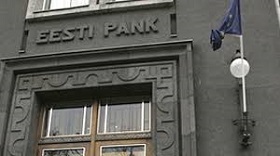Analytics, Economics, Estonia, Financial Services, GDP, Markets and Companies, Wages
International Internet Magazine. Baltic States news & analytics
Friday, 19.04.2024, 00:29
Eesti Pank lowers 2018 economic forecast to 3.5%
 Print version
Print version |
|---|
According to the central bank's June forecast, Estonia's gross domestic product is to total 24.8 billion euros this year and the real growth of GDP 3.5%. In December the bank forecast the GDP growth to total 4.2%, it can be seen from the Bank of Estonia's economic forecast for 2018-2020.
According to the fresh forecast, the Estonian economy is to grow 3.6% next year and will total 26.57 billion euros in current prices, while in December the bank forecast the 2019 economic forecast to total 3.1%. In 2020 the real growth is to total 2.5%, which is 0.2 points less than in the December forecast.
It is quite natural for growth to be slower as there have been fewer unused production resources available with which to grow, and investment statistics indicate that new production capacity is only slowly being added. Higher employment has so far helped to offset the lack of investment, and has been made possible by net immigration in recent years, a temporary increase in the working age population, and more active participation in the labor force, though these beneficial influences are fading, the bank said.
Private consumption growth forecast for this year is 4%, which is 1.1%age points less than in the previous forecast. The government sector's consumption is to increase 1.7%, which is 0.4 points less than in the December forecast.
A consequence of the low level of investment by the business sector is that long-term growth in the economy will be slower. Corporate spending on investment as a ratio to value added has for the past three years held at its level of the crisis period, which is below the average for the countries of the European Union. Estonia has also been a bit less attractive for foreign investment. Assuming that funding conditions remain favorable and given that successful business models require investment in new technology, especially when there are labor shortages, capital needs to be built up over the next two years, though the outlook for this is uncertain.
Although economic growth is slowing, the economy will still be running at above its potential level for the next two years. As part of the economic growth has been driven by increased demand, not by the addition of production capacity, the economy is temporarily above its level. Businesses are not able to increase their production volumes consistently at the same rate as demand, and by the end of the forecast horizon growth will slow down.
Estonia's consumer price index is forecast to grow 2.8% in 2018, 2.5% in 2019 and 1.9% in 2020. The unemployment rate is to total 6.9% this year, 8% next year and 8.2% in 2020.
Along with the faster growth of unemployment, employment is to fall faster than before. This year employment is to decrease by 0.1%, next year by 0.4% and the year after that by 0.1%.
The average gross salary is to grow by 7% to 1,302 euros this year, by 6.4% to 1,385 euros next year and by 5.9% to 1,468 euros in 2020.
The danger is greater than before that growth will slow more steeply than forecast because of unexpected events. This could be caused by deterioration in terms of trade and setbacks in foreign markets, where the outlook has become less certain. The threats of barriers to international trade have started to become real, which has increased the probability of battle lines continuing to be drawn and having a major impact on the global economy.
Companies and households are better protected against a deterioration in the economy than they were earlier. Even if the economy should be hit by some unexpected shocks, both companies and households are better prepared as they have built up savings in recent years and their debt burdens are lower, the central bank said.








 «The Baltic Course» Is Sold and Stays in Business!
«The Baltic Course» Is Sold and Stays in Business!

